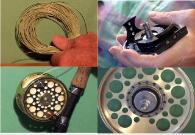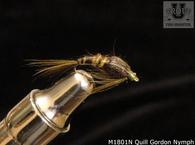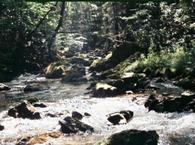
The student will learn about fly line weights, color, buoyancy and taper. After completing this course the student will be equiped to select and assemble the line, backing, leaders, and tippets to the fly fishing rod and reel.
The fly line’s job is to “pull” the fly through the air during the cast. This is the exact opposite scenario as in most types of fishing, where the weight of the lure or bait pulls the line through the air. Therefore, fly line is much heavier and made of different materials than standard monofilament lines.
Fly Rod, Fly Reel, and Fly Line Weight
Fly rod, reel, and line weight selection go hand in hand. The weights of each of these three pieces of equipment should match. That is, choose the rod and reel weights to match the line weight you will be using. To take it a step further, the line weight is determined by the flies you plan to use: the bulkier the fly, the larger the line weight size. For large flies, you may want a 6 weight line; for small dry flies, you may want a 4 weight line. Furthermore, a smaller weight rod will cast with less effort, allowing you a longer day of fishing without fatigue. Therefore, a good compromise, if you’re on a limited budget, is to use a 5 weight fly rod, reel, and line, to match a variety of situations.
Fly Line Taper
Fly line taper refers to the way in which the fly lines diameter changes along the length of the fly line. Typically, fly lines come in 90 foot lengths, and the taper determines how the diameter of the line fluctuates through that 90 feet of line. Below are listed the most common types of tapers:
Level – This type of line has no taper at all; it is the same diameter throughout its entire length. Typically, this is the least expensive, and least useful type of fly line taper.
Double Taper – This type of fly line tapers from a small diameter at each end to a larger diameter toward the center. This type of line taper has the advantage of being symmetrical, and consequently it can be reversed on the fly reel’s spool as one end begins to wear. Additionally, this type of line allows for moderate-length casting and finer presentation (i.e. When the fly hits the water, it creates a smaller impact). It is a good choice of fly line weight for the beginner, or the fly fisher who wants to fish a variety of situations.
Weight Forward – This type of fly line tapers from a small diameter at one end to a large diameter within a relatively short distance from the same end. This allows for longer casts, although the fly’s presentation is adversely impacted. This type of line taper cannot be reversed on the fly reel’s arbor.
Shooting Taper – This is a special type of fly line taper to provide the maximum casting distance. It is rarely used for trout fishing.
Fly Line Buoyancy
Fly line buoyancy is broken down into three main types:
Floating – A floating fly line will float over its entire length. This is the most preferred type of fly line buoyancy by most trout anglers (even for nymphing or using streamers), unless fishing very deep or fast moving water. The line’s floating allows the fisher greater visibility of the line, over its entire length.
Sinking Tip – Sinking tip fly lines have a portion at the end of the line that sinks, while the remainder of the line floats. This is used in faster, deeper water when using wet flies, nymphs, or streamers to get the fly deeper, more quickly. Typically, there is a certain rate at which the tip sinks, allowing the fisher to gage its depth after casting.
Sinking – This type of fly sinks over its entire length. It is similar to using a sinking tip fly line, but it be used to achieve even greater depths, since its entire length sinks.
Fly Line Color
Fly line color has little if any impact on your fishing, beyond making the line visible to you. Pick out a color you like, and go with it.
Fly Line Backing
Typically, the fly line is not connected directly to the reel’s arbor. Rather, a length of (less expensive) line known as backing is attached to the reel’s spool, and the fly line is attached to the backing material. Backing is rarely used (only when a strong fish pulls the entire length of the fly line from the reel) when fighting a fish, and it mostly just takes up space on the reel. Therefore, it is possible to use standard monofilament fishing line as backing, although manufacturers make a special type of line specifically for use as backing. See troutprostore’s class on knots, for information on what knots to use for connecting the backing to the reel’s arbor and fly line.
Fly Fishing Equipment – Leaders & Tippet
Because fly line is much heavier and more visible than standard monofilament lines used more generally in fishing, a section of monofilament, known as the leader, is attached to the end of the fly line. This leader material is similar in appearance to standard fishing line, but it is much stiffer than standard line, allowing the leader to extend fully when cast.
The end of the leader is known as the tippet. It is basically a part of the leader, and if you purchase, rather than make your own, leaders, the tippet will be included as part of the leader. Fly fishers usually carry spools of tippet material (down to 7X, or 0.004” diameter), to replace the material that is lost over time due to wear, breakage, or simply repeatedly tying flies on and cutting them off.
Purchased leaders are typically a single piece of monofilament, tapered continuously from larger diameter at the fly line to smaller diameter at the fly. It is possible, however, to purchase/make leaders that are comprised of a series of short lengths of monofilament, in successively smaller diameters. Tapering the leader is important to prevent knotting of the leader during casting. Leaders (including tippet) will usually come in 7’-9’ lengths. Typically, a shorter leader is used in tight fishing conditions, such as on small streams, whereas longer leaders are used in large, open rivers and lakes.
Important Note:
See troutprostore’s class on knots, for information on what knots to use for connecting the leader to the fly line and tying the tippet to the leader and fly.
Recommended DVD's Getting Started Fly Fishing Basics and more Instructional DVDs





